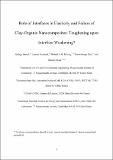| dc.contributor.author | Brochard, Laurent | |
| dc.contributor.author | Hantal, Gyorgy Miklos | |
| dc.contributor.author | Pellenq, Roland Jm | |
| dc.contributor.author | Ulm, Franz-Josef | |
| dc.contributor.author | Coasne, Benoit Alain | |
| dc.date.accessioned | 2018-08-22T18:25:51Z | |
| dc.date.available | 2018-08-22T18:25:51Z | |
| dc.date.issued | 2017-07 | |
| dc.date.submitted | 2017-03 | |
| dc.identifier.issn | 0743-7463 | |
| dc.identifier.issn | 1520-5827 | |
| dc.identifier.uri | http://hdl.handle.net/1721.1/117482 | |
| dc.description.abstract | Synthetic organic-inorganic composites constitute a new class of engineering materials finding applications in an increasing range of fields. The interface between the constituting phases plays a pivotal role in the enhancement of mechanical properties. In exfoliated clay-organic nanocomposites, individual, high aspect ratio clay sheets are dispersed in the organic matrix providing large interfaces and hence efficient stress transfer. In this study, we aim at elucidating molecular-scale reinforcing mechanisms in a series of model clay-organic composite systems by means of reactive molecular simulations. In our models, two possible locations of failure initiation are present: one is the interlayer space of the clay platelet, and the other one is the clay-organic interface. We systematically modify the cohesiveness of the interface and assess how the failure mechanism changes when the different model composites are subjected to a tensile test. Besides a change in the failure mechanism, an increase in the released energy at the interface (meaning an increased overall toughness) are observed upon weakening the interface by bond removal. We propose a theoretical analysis of these results by considering a cohesive law that captures the effect of the interface on the composite mechanics. We suggest an atomistic interpretation of this cohesive law, in particular, how it relates to the degree of bonding at the interface. In a broader perspective, this work sheds light on the importance of the orthogonal behavior of interfaces to nanocomposites. | en_US |
| dc.description.sponsorship | MIT Energy Initiative | en_US |
| dc.description.sponsorship | Schlumberger Limited | en_US |
| dc.description.sponsorship | Shell Oil Company | en_US |
| dc.description.sponsorship | French Research National Agency (ANR-11-LABX-0053) | en_US |
| dc.description.sponsorship | French Research National Agency (ANR-11-IDEX-0001-02) | en_US |
| dc.publisher | American Chemical Society (ACS) | en_US |
| dc.relation.isversionof | http://dx.doi.org/10.1021/ACS.LANGMUIR.7B01071 | en_US |
| dc.rights | Article is made available in accordance with the publisher's policy and may be subject to US copyright law. Please refer to the publisher's site for terms of use. | en_US |
| dc.source | Other repository | en_US |
| dc.title | Role of Interfaces in Elasticity and Failure of Clay–Organic Nanocomposites: Toughening upon Interface Weakening? | en_US |
| dc.type | Article | en_US |
| dc.identifier.citation | Hantal, György, et al. “Role of Interfaces in Elasticity and Failure of Clay–Organic Nanocomposites: Toughening upon Interface Weakening?” Langmuir, vol. 33, no. 42, Oct. 2017, pp. 11457–66. © 2017 American Chemical Society. | en_US |
| dc.contributor.department | Massachusetts Institute of Technology. Department of Civil and Environmental Engineering | en_US |
| dc.contributor.mitauthor | Hantal, Gyorgy Miklos | |
| dc.contributor.mitauthor | Pellenq, Roland Jm | |
| dc.contributor.mitauthor | Ulm, Franz-Josef | |
| dc.contributor.mitauthor | Coasne, Benoit Alain | |
| dc.relation.journal | Langmuir | en_US |
| dc.eprint.version | Author's final manuscript | en_US |
| dc.type.uri | http://purl.org/eprint/type/JournalArticle | en_US |
| eprint.status | http://purl.org/eprint/status/PeerReviewed | en_US |
| dc.date.updated | 2018-08-21T15:10:07Z | |
| dspace.orderedauthors | Hantal, György; Brochard, Laurent; Pellenq, Roland J.-M.; Ulm, Franz-Joseph; Coasne, Benoit | en_US |
| dspace.embargo.terms | N | en_US |
| dc.identifier.orcid | https://orcid.org/0000-0001-5559-4190 | |
| dc.identifier.orcid | https://orcid.org/0000-0002-7089-8069 | |
| mit.license | PUBLISHER_POLICY | en_US |
